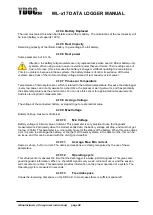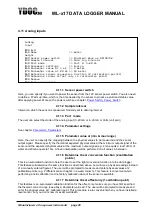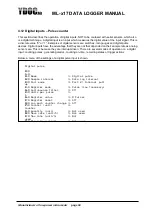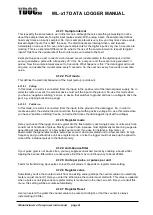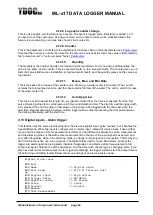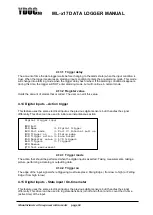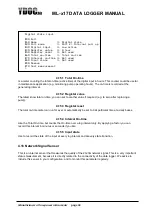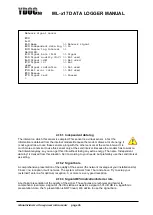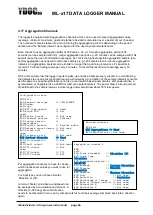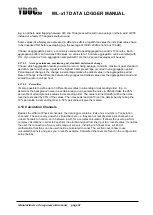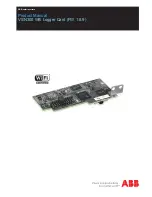
ML-x17 DATA LOGGER MANUAL
Manufacturers of low power instruments
page 32
mode, changes this. When the sample interval of concerned sensor is set to i.e. 1 minute, the data logger
will wake every minute, and take a measurement, but NOT store this on the SD Card. So, the user ends
up with a normal data file, with every 10 minutes a new data record, and the system is responding within
1-minute max. on an alarm situation.
4.5.7 Alarm output port
The “Alarm output port” can be used to “switch on” or “trigger” an
external device in case of an alarm situation
by means of an “
”. When in “Continuous state” the output will be
activated as long as an alarm situation exists. If you only want to
trigger an external device when a new alarm situation occurs, you
can specify a “One-time pulse” with a certain pulse width in
seconds. If you want to re-trigger the external device at every
sample interval, while in alarm, choose “Repeating pulse”.
Note: When a logger is awake (e.g. during USB connection) and frequently sampling its sensors and
inputs
then “repeating pulse” may look similar to “continuous state”, due to overlapping pulses.
4.5.8 Bower supply board
An ML-x17 can be provisioned with various power supply boards working with different type of battery
chemistries. Please select a board type matching with your hardware. If
you don’t know specify the
Battery type instead in the next option.
4.5.9 Battery (protection & lifespan)
This setting is automatic applied if you have previously chosen a matching power supply board.
Choose ‘LFP’ when using LiFePO4 3.2V batteries, in this mode the data logger will not start if the voltage
is below 2.8V, giving a DC-source (e.g. solar panel) the chance to sufficiently replenish a depleted battery
and it will also if necessary prevent the batteries from over charging by applying a load till voltage drops
below a safe level.
Choose ‘NiMH’ when using NiMH AA batteries, in this mode the data logger will not start if the voltage is
below 3.4V, giving a DC-source (e.g. solar panel) the chance to sufficiently replenish a depleted battery.
C
hoose ‘Lithium batteries’ when primary batteries are used, this will prevent the batteries to be drained
while connected to USB by going in to low-power sleep after 3 minutes of non-activity. In this mode the
logger can also detect when the Lithium battery is used in a DC-LI edition, to be able to calculate the
remaining Lithium battery capacity.
Choose ‘None’ when using an external 12V (SLA/ LiFePO4) battery or a DC-source without batteries,
4.5.10 Deployment Date and Time
Here you enter the specific Date & Time On which you like the measurements to start for the first time.
This feature allows you to configure your data logger (in a nice and warm environment) before you install
it in the field. It prevents the device to measure and send fake data, due to the dislocation of the unit. If
this feature is used, the unit will sleep until the deployment start date & time. You can also specify a date
time when the data logger should stop with measuring and transmitting.
Alarm output port
[0] Exit
[1] Disabled
[2] Continuous state
[3] One-time pulse
[4] Repeating pulse
>Pulse width (sec):





















